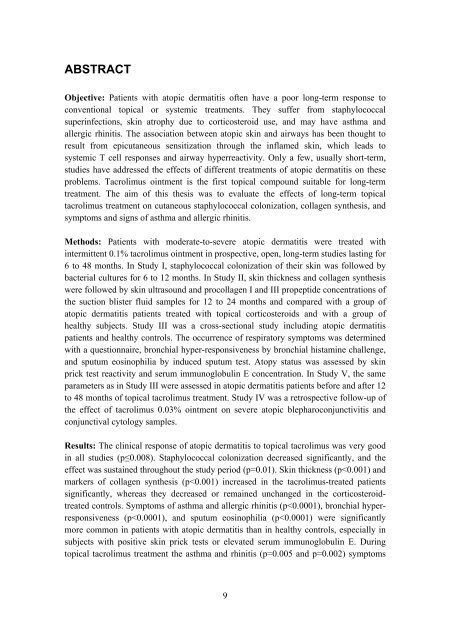Topical tacrolimus in atopic dermatitis: Effects of ... - Helda - Helsinki.fi
Topical tacrolimus in atopic dermatitis: Effects of ... - Helda - Helsinki.fi
Topical tacrolimus in atopic dermatitis: Effects of ... - Helda - Helsinki.fi
You also want an ePaper? Increase the reach of your titles
YUMPU automatically turns print PDFs into web optimized ePapers that Google loves.
ABSTRACT<br />
Objective: Patients with <strong>atopic</strong> <strong>dermatitis</strong> <strong>of</strong>ten have a poor long-term response to<br />
conventional topical or systemic treatments. They suffer from staphylococcal<br />
super<strong>in</strong>fections, sk<strong>in</strong> atrophy due to corticosteroid use, and may have asthma and<br />
allergic rh<strong>in</strong>itis. The association between <strong>atopic</strong> sk<strong>in</strong> and airways has been thought to<br />
result from epicutaneous sensitization through the <strong>in</strong>flamed sk<strong>in</strong>, which leads to<br />
systemic T cell responses and airway hyperreactivity. Only a few, usually short-term,<br />
studies have addressed the effects <strong>of</strong> different treatments <strong>of</strong> <strong>atopic</strong> <strong>dermatitis</strong> on these<br />
problems. Tacrolimus o<strong>in</strong>tment is the <strong>fi</strong>rst topical compound suitable for long-term<br />
treatment. The aim <strong>of</strong> this thesis was to evaluate the effects <strong>of</strong> long-term topical<br />
<strong>tacrolimus</strong> treatment on cutaneous staphylococcal colonization, collagen synthesis, and<br />
symptoms and signs <strong>of</strong> asthma and allergic rh<strong>in</strong>itis.<br />
Methods: Patients with moderate-to-severe <strong>atopic</strong> <strong>dermatitis</strong> were treated with<br />
<strong>in</strong>termittent 0.1% <strong>tacrolimus</strong> o<strong>in</strong>tment <strong>in</strong> prospective, open, long-term studies last<strong>in</strong>g for<br />
6 to 48 months. In Study I, staphylococcal colonization <strong>of</strong> their sk<strong>in</strong> was followed by<br />
bacterial cultures for 6 to 12 months. In Study II, sk<strong>in</strong> thickness and collagen synthesis<br />
were followed by sk<strong>in</strong> ultrasound and procollagen I and III propeptide concentrations <strong>of</strong><br />
the suction blister fluid samples for 12 to 24 months and compared with a group <strong>of</strong><br />
<strong>atopic</strong> <strong>dermatitis</strong> patients treated with topical corticosteroids and with a group <strong>of</strong><br />
healthy subjects. Study III was a cross-sectional study <strong>in</strong>clud<strong>in</strong>g <strong>atopic</strong> <strong>dermatitis</strong><br />
patients and healthy controls. The occurrence <strong>of</strong> respiratory symptoms was determ<strong>in</strong>ed<br />
with a questionnaire, bronchial hyper-responsiveness by bronchial histam<strong>in</strong>e challenge,<br />
and sputum eos<strong>in</strong>ophilia by <strong>in</strong>duced sputum test. Atopy status was assessed by sk<strong>in</strong><br />
prick test reactivity and serum immunoglobul<strong>in</strong> E concentration. In Study V, the same<br />
parameters as <strong>in</strong> Study III were assessed <strong>in</strong> <strong>atopic</strong> <strong>dermatitis</strong> patients before and after 12<br />
to 48 months <strong>of</strong> topical <strong>tacrolimus</strong> treatment. Study IV was a retrospective follow-up <strong>of</strong><br />
the effect <strong>of</strong> <strong>tacrolimus</strong> 0.03% o<strong>in</strong>tment on severe <strong>atopic</strong> blepharoconjunctivitis and<br />
conjunctival cytology samples.<br />
Results: The cl<strong>in</strong>ical response <strong>of</strong> <strong>atopic</strong> <strong>dermatitis</strong> to topical <strong>tacrolimus</strong> was very good<br />
<strong>in</strong> all studies (p�0.008). Staphylococcal colonization decreased signi<strong>fi</strong>cantly, and the<br />
effect was susta<strong>in</strong>ed throughout the study period (p=0.01). Sk<strong>in</strong> thickness (p

















